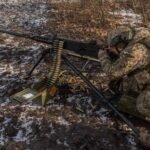Arms deals, at the cost of conflicts in Europe, Asia and the Middle East
Eduardo Lliteras
06/20/2023 | Merida Yucatan
While Ukraine bleeds to death and men and women from Russia and other NATO nations involved in the conflict as mercenaries are dying daily on the front lines, the military budget in the world, and in particular in Europe, continues to grow. And from what is expected it will continue like this for at least the next decade. Instead of governments investing in combating climate change, poverty, and inequality, the budgetary effort dedicated to the accumulation of weapons only heralds more conflicts and destruction, with serious ecological and human consequences. The hypocrisy of the powers is more than evident.
Indeed. Military spending in Europe has increased faster than anywhere else in the world. Military spending in Europe experienced its biggest year-on-year increase in at least 30 years. The top three spending countries in 2022 — the United States, China and Russia — accounted for 56 percent of the world total, according to new data on global military spending released recently by the Stockholm International Peace Research Institute (SIPRI). .
In this way, the arms business is going from strength to strength for the military industry around the world. The European Union, spurred on by the arms industry lobby, increased its military budget by 183 percent over last year. Germany is about to sign the largest arms deal in Israel’s history, says the Israeli daily Haaretz , which claims, citing diplomatic sources, that this is just the beginning.
Haaretz explains that Germany and Israel are advancing the largest Israeli defense export deal in history. For its part, Finland becomes the first European country to acquire Israel’s David’s Sling air defense system; Elbit Systems Wins $305 Million Contract With The Netherlands; Estonia is buying Israeli drones in a deal worth more than 100 million euros, adds Haaretz .
In addition, while the borders are closed for immigrants from Africa or the Middle East where wars take place (such as in Sudan or Yemen) that have almost no echo in the Western media, the military spending of the Central and Western European states totaled 345 billion in 2022. In real terms, spending by these states exceeded for the first time that of 1989, when the cold war was ending, and was 30 percent higher than in 2013. Several of the European governments significantly increased their military spending after of the Russian invasion of Ukraine in February 2022, while others announced plans to increase spending levels for periods of up to a decade.
Some of the most pronounced increases were observed in Finland (+36 percent), Lithuania (+27 percent), Sweden (+12 percent) and Poland (+11 percent), according to data published in the Old Continent media.
Likewise, according to a cable from the French agency AFP , the world’s nuclear powers, and China in particular, increased investment in their arsenals for the third consecutive year in 2022 amid growing geopolitical tensions, which have reached the extreme of fearing an explosion. of another conflict between China and the United States and its allies. The so-called AUKUS deal between Australia, the United States and the United Kingdom will see Canberra shell out billions of dollars over the next three decades to acquire a fleet of nuclear submarines.
“AUKUS signals further militarization by linking Australia to the networks of US military bases in the North Pacific and is unleashing an arms race by bringing the war much closer to home,” denounced regional leaders who expressed extreme concern about the escalation of the war. Australian under Anglo-American tutelage and questioned that not even a tenth of the money allocated to the aforementioned military project is directed to combat climate change.
For example, Cambodia’s prime minister said the US-led anti-China military alliance with Australia and the UK, AUKUS, is the “starting point of a very dangerous arms race.” He stressed that Southeast Asia must remain a “nuclear-weapon-free zone.”
Yet the world’s nine nuclear weapon states collectively spent $82.9 billion on their arsenals last year, with the United States accounting for more than half of that, according to a new report from the International Campaign to Abolish Nuclear Weapons (ICAN). , according to data from the AFP agency.
The reality, as SIPRI notes, global military spending increased by 3.7 percent in real terms in 2022, to reach a record $2.24 billion. Global spending grew 19 percent over the decade 2013-22 and has risen every year since 2015. The Russian invasion of Ukraine was a major driver of spending growth in 2022. Military spending in Europe increased 13 percent over the year, which was the largest annual increase in total European spending in the post-Cold War era. The exceptional growth was largely due to substantial increases in spending by Russia and Ukraine, but many other European countries increased their military budgets in 2022. Spending increases in parts of Asia and Oceania also contributed to global growth in 2022.
At the same time, activists around the world are calling for the abolition of borders, a reduction in military budgets, and investments in public policies that actually make people safer.
And they point out that the European Union (EU) has used the war in Ukraine to expand its deadly border regime in Eastern Europe, redoubling its efforts to keep out those fleeing wars and conflicts in the world other than Ukraine. Furthermore, they point out, Ukraine, which has acted as the EU’s border guard for almost two decades, has continued to play this role even as the war continues.
The reality is that since the mid-2000s, the European Union has financed the construction of detention centers located deep within Ukrainian territory where those bound for or deported from the European Union have been held. We are talking about people from sub-Saharan Africa, Syrians, Afghans, Iraqis. Countries in which the EU and NATO have sown wars, militarized conflicts.
Source: lajornadamaya











